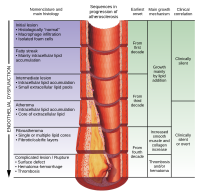
Photo from wikipedia
Abstract The presence of tortuosity in coronary artery (CA) affects the local wall shear stress (WSS) which is an influencing hemodynamic descriptor (HD) for the development of atherosclerotic sites. To… Click to show full abstract
Abstract The presence of tortuosity in coronary artery (CA) affects the local wall shear stress (WSS) which is an influencing hemodynamic descriptor (HD) for the development of atherosclerotic sites. To conduct a morphological parametric study in coronary arteries (CAs), several idealized tortuous artery models were obtained by varying three morphological indices namely, curvature radius (CR), distance between two bends (DBB) and the angle of bend (AoB). Computational fluid dynamics methodology with multiphase mixture theory is used to explore the effect of coronary tortuosity on various WSS based hemodynamic descriptors (HDs) namely, time-averaged WSS, oscillatory shear index, time-averaged WSS gradient, endothelial cell activation potential and the relative residence time that are used to determine the vulnerable locations for the onset of thrombosis and atherosclerosis. Our findings suggest that all the tortuosity morphological indices, CR, DBB and AoB have significant influence on the distributions of various HDs and hemodynamics. It is also observed that atherosclerosis prone sites were witnessed at the inner artery wall at downstream regions of the bend section 1 and bend section 2 in all the tortuous artery models studied and found to increase as the CR and DBB were reduced however, found to increase as the AoB is increased. Hence, severe coronary tortuosity in CAs with small CR, small DBB and higher AoB may have lower WSS zones at inner bend sections which promote atherosclerosis plaque progression. The analysis obtained from this multiphase blood flow study can be employed potentially in the clinical assessment on the severity of atherosclerosis lesions as well as in understanding the underlying mechanisms of localization and formation of atherosclerotic plaques.
Journal Title: Biocybernetics and Biomedical Engineering
Year Published: 2020
Link to full text (if available)
Share on Social Media: Sign Up to like & get
recommendations!